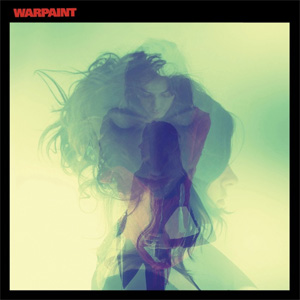Ten seconds into “Intro,” drummer Stella Mozgawa, out of sync with guitarist Theresa Wayman, cuts out, yelling “Ah, sorry!” and casually counting off the tempo on her sticks before the entire group comes in together. This opening to Warpaint’s eponymous second album is reminiscent of Bob Dylan’s “115th Dream”; both tracks serve to make the listener aware of the complex entity that is a live band. For Dylan, the inclusion of the botched-and-then-patched beginning is his departure from self-strummed acoustics and a declaration of his new group’s tightness. Warpaint’s statement is more measured: in an indie-rock landscape where highly produced digital elements, particularly those derived from EDM, are integral to innovation, Warpaint is intrigued but still achingly human. Accordingly, on their second LP, the group augments their intimate instrumental sound with unexpected stylistic subtleties to craft consistently beautiful and provocative songs of love and loss.
“Warpaint” is still a far more produced album than the group’s debut, “The Fool,” which hardly touched the drum loops, synthesizers, vocal ambience, and overdubs that often appear on their new album. Producer Flood, famed for his ability to incorporate electronic elements into the recorded work of virtuosic rock players, sprinkles the record with subtle effects. In “Hi,” a simultaneously melodic and throbbingly rhythmic track that is arguably the best on the album, a trip-hoppy drum loop underscores the opening verse. Yet just as it seems that the beat will accompany the entirety of the song, Mozgawa reemerges with a strikingly odd fill. The deviation from the loop is so subtle that the most pressing question is not “How did they incorporate that effect?” but rather, “Was that an effect?”
Flood’s treatment of lead singer Emily Kokal’s voice on “Hi” is just as restrained. At first, intense reverb accompanies the end of each ethereal and cryptic verse, which seems to tell the story of a weak and troubled lover. The effect makes Kokel sound distant and almost robotic. As with the drums, however, this remoteness quickly disappears when a gasping breath from Kokal immediately reaffirms her humanity. Other effects work in much the same way, giving a glimpse of the computerized before pulling back to reveal an undoctored strum, breath, or drumbeat. Warpaint, resisting the urge to overuse synthetic and unexpected sounds, utilize the digital sparingly to magnify the unenhanced.
The increased focus on Kokal’s voice granted by the production allows the vocalist’s talent to come through. Her voice intermingles with the melodies of the instruments and sometimes acts as an instrument in itself, cooing, moaning, and slurring off of notes. The synthesizer, which often has a similar tone and timbre to Kokal’s low-vibrato lines, is sometimes indistinguishable from her singing. The track “CC,” devolves into a disorienting siren song, with the three harmonic melodies melding into a single beautiful chord. Occasionally, and most noticeably on the mellower second-side tracks “Go In” and “Son,” the synth-voice combination becomes soupy and lethargic. On the faster tracks, however, the effect is gorgeous and eerie.
Wayman’s guitar lines interact equally fluidly with Kokal’s timbre and melodies. In “Feeling Alright,” Kokal’s voice floats onto the root of a major chord a fraction of a second before Wayman’s lead guitar joins her, effectively transposing the song in a call-and-response fashion. There is no artificial break or musical showboating here or anywhere else on the record. The transpositions and other musical idiosyncrasies are so hidden that they only fully reveal themselves slowly through multiple listens.
The lack of lyrical specificity is the album’s primary weakness. Warpaint’s debut, “The Fool,” relies largely on poetic words and concepts, but is still anchored in contemporary lore, as evidenced by the popular track “Billie Holliday,” and other references to the modern. “Warpaint,” however, drops any remaining vestiges of contemporary referentiality. The album is often unanchored contextually, relying on wrenching but vague lyrics centered around the very human elements of love, betrayal, and death. By the end of the album, the lyrics fade largely into the background.
The lyrics that do stand out, however, are more heavily sexually tinged than those of their debut, which was by no means a puritanical album. “Biggy” has an extended outro centered on the repeated phrase “heat of a lover.” Kokal moans the words, offering up an affecting eroticism despite the dearth of directly explicit content. Although the steamier lyrics often complement the sensual instrumental mood of the album, their opaqueness is still more distracting than beneficial.
Whether “Warpaint” can emulate Dylan by continuing to grow without losing the balance between technical innovation and instrumental integrity is unclear; they certainly need to become more lyrical and find a workable aesthetic for their softer songs. For the moment, however, their ability to create raw and honest ruminations that still have a modern and unique sound is undeniably impressive.
—Staff writer David J. Kurlander can be reached at davidkurlander@college.harvard.edu.
Read more in Arts
"Andrew's Brain" by E. L. Doctorow













